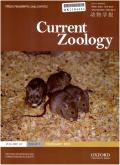大闸蟹自体切除后性状再生和交配策略的影响
IF 2
2区 生物学
Q2 ZOOLOGY
引用次数: 0
摘要
雄性大闸蟹有一个增大的爪子,既是武器也是装饰品。这一爪子从幼体阶段开始增大,并持续一生。雄性大闸蟹可能会自愿失去(即自动蜕皮)这只爪子。经过几次蜕皮后,雄性可能会再生出一个新的爪子,称为 "左爪"(leptochelous),它的长度与原来的爪子相似,但肌肉面积比原来的爪子小,称为 "右爪"(brachychelous)。在某些物种中,再生的爪子会永久性地发育成鳞爪,使种群具有两种不同的爪子形态。其他物种则表现出形态上的变异,鳞爪和腕爪是连续体的两端。我们研究了乌拉圭钩麻蜥这一增大爪的形态变化,它是否会因雄性个体大小不同而再生,以及它对交配成功率的影响。我们发现,爪不能被区分为不同的形态,这表明从腕状爪到钩状爪是一个形态连续体。实验室中再生的爪子最初较小,与体型成正比,而野外实验证实,爪子的大小在数次蜕皮后会恢复。形态变化可能是由于能量限制造成的,不同体型的雄蟹必须在恢复爪的长度(装饰功能)或爪的肌肉面积(武器功能)之间做出不同的权衡。大闸蟹采用两种交配策略,雌蟹的选择程度不同。然而,无论采用哪种交配策略,在高密度条件下,无爪雄蟹都处于劣势,而在低密度条件下则不然,这表明自切和再生对交配成功率的影响可能取决于社会环境。本文章由计算机程序翻译,如有差异,请以英文原文为准。
The influence of the post-autotomy regeneration of a sexual trait and mating tactics in a fiddler crab
Male fiddler crabs own an enlarged claw which is a weapon and an ornament. The enlargement of this claw begins from the juvenile stage and continues throughout life. Males may voluntarily lose (i.e. autotomise) this claw. After several moults males may regenerate a new claw, called leptochelous, which acquires a similar length but a lower muscle mass area than the original one, called brachychelous. In some species, regenerated claws develop permanently as leptochelous, the population having two discrete claw morphologies. Other species present morphological variations with leptochelous and brachychelous being two ends of a continuum. In the species Leptuca uruguayensis, we studied the morphological variation of this enlarged claw, whether it may be caused by its regeneration at different male sizes, and its consequences on mating success. We found that claws could not be discriminated as discrete morphs, suggesting a morphological continuum from brachychelous to leptochelous. Regenerated claws in the laboratory were initially small and proportional to body size, while a field experiment confirmed that claw size is recovered after several moults. Morphological variation may be caused by energetic limitations where males of different sizes must differently trade-off between restitution of claw length (ornament function) or claw muscle area (weapon function). Fiddler crabs use two mating tactics with different levels of female choice. However, regardless of the mating tactic, leptochelous males were at a disadvantage at high densities, while not at low densities, suggesting that the consequences of autotomy and regeneration on mating success may depend on the social context.
求助全文
通过发布文献求助,成功后即可免费获取论文全文。
去求助
来源期刊

Current Zoology
Agricultural and Biological Sciences-Animal Science and Zoology
CiteScore
3.20
自引率
9.10%
发文量
111
审稿时长
6 weeks
期刊介绍:
About the Journal
Current Zoology (formerly Acta Zoologica Sinica, founded in 1935) is an open access, bimonthly, peer-reviewed international journal of zoology. It publishes review articles and research papers in the fields of ecology, evolution and behaviour.
Current Zoology is sponsored by Institute of Zoology, Chinese Academy of Sciences, along with the China Zoological Society.
 求助内容:
求助内容: 应助结果提醒方式:
应助结果提醒方式:


